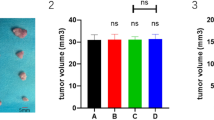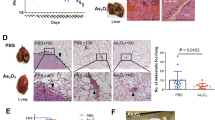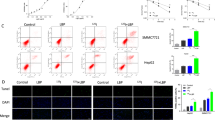Abstract
Previous studies have shown that the application of Ad/AFPtBid significantly and specifically killed hepatocellular carcinoma (HCC) cells in culture and subcutaneously implanted in mice. This study was to test the therapeutic efficacy of Ad/AFPtBid in an orthotopic hepatic tumor model. Four weeks after implantation of tumor cells into the liver, nude mice were treated with Ad/AFPtBid alone or in combination with 5-fluorouracil (5-FU). Serum α-fetoprotein (AFP) was measured as a marker for tumor progression. The results showed that Ad/AFPtBid significantly inhibited Hep3B tumor growth. Ad/AFPtBid and 5-FU in combination was more effective than either agent alone. Tumor tissues of Ad/AFPtBid alone or combination treatment groups showed a decrease in cells positive for proliferation cell nuclear antigen, but an increase in apoptosis. Ad/AFPtBid did not suppress the hepatic tumor formed by non-AFP-producing hepatoma SK-HEP-1 cells or colorectal adenocarcinoma DLD-1 cells. The survival rate was higher in mice treated with Ad/AFPtBid plus 5-FU than those treated with either agent alone. No acute toxic effect was observed in mice receiving Ad/AFPtBid. Collectively, Ad/AFPtBid can specifically target and effectively suppress the AFP-producing orthotopic liver tumor in mice without obvious toxicity, indicating that it is a promising tool in combination with chemotherapeutic agents for treatment of AFP-producing HCC.
This is a preview of subscription content, access via your institution
Access options
Subscribe to this journal
Receive 12 print issues and online access
$259.00 per year
only $21.58 per issue
Buy this article
- Purchase on Springer Link
- Instant access to full article PDF
Prices may be subject to local taxes which are calculated during checkout






Similar content being viewed by others
References
WHO. The World Health Organization's Fight Against Cancer: Strategies that Prevent, Cure and Care. WHO Press, World Health Organization, Geneva, Switzerland 2007, ISBN 978 92 4 159543 8 (NLM classification: QZ 200).
NIH. Cancer trends progress report - 2007 Update, National Cancer Institute, NIH, DHHS, Bethesda, MD, December 2007, 〈http://progressreport.cancer.gov〉.
WHO. World Health Statistic 2008. WHO Press, World Health Organization, Geneva, Switzerland 2008, ISBN 978 92 4156359 8 (NLM classification: WA 900.1) ISBN 978 92 4 0682740 (electronic version).
Avila MA, Berasain C, Sangro B, Prieto J . New therapies for hepatocellular carcinoma. Oncogene 2006; 25: 3866–3884.
Ganne-Carrie N, Trinchet JC . Systemic treatment of hepatocellular carcinoma. Eur J Gastroenterol Hepatol 2004; 16: 275–281.
Mott JL, Gores GJ . Piercing the armor of hepatobiliary cancer: Bcl-2 homology domain 3 (BH3) mimetics and cell death. Hepatology 2007; 46: 906–911.
Chiu CT, Yeh TS, Hsu JC, Chen MF . Expression of Bcl-2 family modulated through p53-dependent pathway in human hepatocellular carcinoma. Dig Dis Sci 2003; 48: 670–676.
Sieghart W, Losert D, Strommer S, Cejka D, Schmid K, Rasoul-Rockenschaub S et al. Mcl-1 overexpression in hepatocellular carcinoma: a potential target for antisense therapy. J Hepatol 2006; 44: 151–157.
Chen GG, Lai PB, Chan PK, Chak EC, Yip JH, Ho RL et al. Decreased expression of Bid in human hepatocellular carcinoma is related to hepatitis B virus X protein. Eur J Cancer 2001; 37: 1695–1702.
Liu LX, Jiang HC, Liu ZH, Zhu AL, Zhou J, Zhang WH et al. Gene expression profiles of hepatoma cell line BEL-7402. Hepatogastroenterology 2003; 50: 1496–1501.
Ding WX, Ni HM, DiFrancesca D, Stolz DB, Yin XM . Bid-dependent generation of oxygen radicals promotes death receptor activation-induced apoptosis in murine hepatocytes. Hepatology 2004; 40: 403–413.
Li S, Zhao Y, He X, Kim TH, Kuharsky DK, Rabinowich H et al. Relief of extrinsic pathway inhibition by the Bid-dependent mitochondrial release of Smac in Fas-mediated hepatocyte apoptosis. J Biol Chem 2002; 277: 26912–26920.
Yin XM, Wang K, Gross A, Zhao Y, Zinkel S, Klocke B et al. Bid-deficient mice are resistant to Fas-induced hepatocellular apoptosis. Nature 1999; 400: 886–891.
Zhao Y, Ding WX, Qian T, Watkins S, Lemasters JJ, Yin XM . Bid activates multiple mitochondrial apoptotic mechanisms in primary hepatocytes after death receptor engagement. Gastroenterology 2003; 125: 854–867.
Wei MC, Zong WX, Cheng EH, Lindsten T, Panoutsakopoulou V, Ross AJ et al. Proapoptotic BAX and BAK: a requisite gateway to mitochondrial dysfunction and death. Science 2001; 292: 727–730.
Wei MC, Lindsten T, Mootha VK, Weiler S, Gross A, Ashiya M et al. tBID, a membrane-targeted death ligand, oligomerizes BAK to release cytochrome c. Genes Dev 2000; 14: 2060–2071.
Chang YC, Xu YH . Expression of Bcl-2 inhibited Fas-mediated apoptosis in human hepatocellular carcinoma BEL-7404 cells. Cell Res 2000; 10: 233–242.
Kim JY, Kim YH, Chang I, Kim S, Pak YK, Oh BH et al. Resistance of mitochondrial DNA-deficient cells to TRAIL: role of Bax in TRAIL-induced apoptosis. Oncogene 2002; 21: 3139–3148.
Chen GG, Lai PB, Chak EC, Xu H, Lee KM, Lau WY . Immunohistochemical analysis of pro-apoptotic Bid level in chronic hepatitis, hepatocellular carcinoma and liver metastases. Cancer Lett 2001; 172: 75–82.
Miao J, Chen GG, Chun SY, Yun JP, Chak EC, Ho RL et al. Adenovirus-mediated tBid overexpression results in therapeutic effects on p53-resistant hepatocellular carcinoma. Int J Cancer 2006; 119: 1985–1993.
Miao J, Chen GG, Chun SY, Chak EC, Lai PB . Bid sensitizes apoptosis induced by chemotherapeutic drugs in hepatocellular carcinoma. Int J Oncol 2004; 25: 651–659.
Schmitz V, Qian C, Ruiz J, Sangro B, Melero I, Mazzolini G et al. Gene therapy for liver diseases: recent strategies for treatment of viral hepatitis and liver malignancies. Gut 2002; 50: 130–135.
Moon C, Oh Y, Roth JA . Current status of gene therapy for lung cancer and head and neck cancer. Clin Cancer Res 2003; 9: 5055–5067.
Yao X, Hu JF, Daniels M, Yien H, Lu H, Sharan H et al. A novel orthotopic tumor model to study growth factors and oncogenes in hepatocarcinogenesis. Clin Cancer Res 2003; 9: 2719–2726.
Wilmanns C, Fan D, O’Brian CA, Bucana CD, Fidler IJ . Orthotopic and ectopic organ environments differentially influence the sensitivity of murine colon carcinoma cells to doxorubicin and 5-fluorouracil. Int J Cancer 1992; 52: 98–104.
Iizuka N, Oka M, Yamada-Okabe H, Nishida M, Maeda Y, Mori N et al. Oligonucleotide microarray for prediction of early intrahepatic recurrence of hepatocellular carcinoma after curative resection. Lancet 2003; 361: 923–929.
Huang YH, Chen CH, Chang TT, Chen SC, Wang SY, Lee HS et al. Evaluation of predictive value of CLIP, Okuda, TNM and JIS staging systems for hepatocellular carcinoma patients undergoing surgery. J Gastroenterol Hepatol 2005; 20: 765–771.
Kanda M, Tateishi R, Yoshida H, Sato T, Masuzaki R, Ohki T et al. Extrahepatic metastasis of hepatocellular carcinoma: incidence and risk factors. Liver Int 2008; 28: 1256–1263.
Peng SY, Lai PL, Chu JS, Lee PH, Tsung PT, Chen DS et al. Expression and hypomethylation of alpha-fetoprotein gene in unicentric and multicentric human hepatocellular carcinomas. Hepatology 1993; 17: 35–41.
Trevisani F, D’Intino PE, Morselli-Labate AM, Mazzella G, Accogli E, Caraceni P et al. Serum alpha-fetoprotein for diagnosis of hepatocellular carcinoma in patients with chronic liver disease: influence of HBsAg and anti-HCV status. J Hepatol 2001; 34: 570–575.
Marubashi S, Dono K, Nagano H, Sugita Y, Asaoka T, Hama N et al. Detection of AFP mRNA-expressing cells in the peripheral blood for prediction of HCC recurrence after living donor liver transplantation. Transpl Int 2007; 20: 576–582.
Wills KN, Maneval DC, Menzel P, Harris MP, Sutjipto S, Vaillancourt MT et al. Development and characterization of recombinant adenoviruses encoding human p53 for gene therapy of cancer. Hum Gene Ther 1994; 5: 1079–1088.
Yin XM . Bid, a critical mediator for apoptosis induced by the activation of Fas/TNF-R1 death receptors in hepatocytes. J Mol Med 2000; 78: 203–211.
Sakon M, Nagano H, Dono K, Nakamori S, Umeshita K, Yamada A et al. Combined intraarterial 5-fluorouracil and subcutaneous interferon-alpha therapy for advanced hepatocellular carcinoma with tumor thrombi in the major portal branches. Cancer 2002; 94: 435–442.
Patt YZ, Hassan MM, Lozano RD, Brown TD, Vauthey JN, Curley SA et al. Phase II trial of systemic continuous fluorouracil and subcutaneous recombinant interferon Alfa-2b for treatment of hepatocellular carcinoma. J Clin Oncol 2003; 21: 421–427.
Ishikawa Y, Kubota T, Otani Y, Watanabe M, Teramoto T, Kumai K et al. Dihydropyrimidine dehydrogenase activity and messenger RNA level may be related to the antitumor effect of 5-fluorouracil on human tumor xenografts in nude mice. Clin Cancer Res 1999; 5: 883–889.
Boucher E, Corbinais S, Brissot P, Boudjema K, Raoul JL . Treatment of hepatocellular carcinoma (HCC) with systemic chemotherapy combining epirubicin, cisplatinum and infusional 5-fluorouracil (ECF regimen). Cancer Chemother Pharmacol 2002; 50: 305–308.
Macdonald JS . Toxicity of 5-fluorouracil. Oncology (Williston Park) 1999; 13: 33–34.
Li Y, Yu DC, Chen Y, Amin P, Zhang H, Nguyen N et al. A hepatocellular carcinoma-specific adenovirus variant, CV890, eliminates distant human liver tumors in combination with doxorubicin. Cancer Res 2001; 61: 6428–6436.
Klimtova I, Simunek T, Mazurova Y, Hrdina R, Gersl V, Adamcova M . Comparative study of chronic toxic effects of daunorubicin and doxorubicin in rabbits. Hum Exp Toxicol 2002; 21: 649–657.
Nazeyrollas P, Frances C, Prevost A, Costa B, Lorenzato M, Kantelip JP et al. Efficiency of amifostine as a protection against doxorubicin toxicity in rats during a 12-day treatment. Anticancer Res 2003; 23: 405–409.
Ikebukuro K, Adachi Y, Toki J, Taketani S, Tokunaga R, Hioki K et al. Morphological change, loss of deltapsi(m) and activation of caspases upon apoptosis of colorectal adenocarcinoma induced by 5-FU. Cancer Lett 2000; 153: 101–108.
Xu ZW, Friess H, Buchler MW, Solioz M . Overexpression of Bax sensitizes human pancreatic cancer cells to apoptosis induced by chemotherapeutic agents. Cancer Chemother Pharmacol 2002; 49: 504–510.
Yoshikawa R, Kusunoki M, Yanagi H, Noda M, Furuyama JI, Yamamura T et al. Dual antitumor effects of 5-fluorouracil on the cell cycle in colorectal carcinoma cells: a novel target mechanism concept for pharmacokinetic modulating chemotherapy. Cancer Res 2001; 61: 1029–1037.
Lee BJ, Chon KM, Kim YS, An WG, Roh HJ, Goh EK et al. Effects of cisplatin, 5-fluorouracil, and radiation on cell cycle regulation and apoptosis in the hypopharyngeal carcinoma cell line. Chemotherapy 2005; 51: 103–110.
Geoerger B, Vassal G, Opolon P, Dirven CM, Morizet J, Laudani L et al. Oncolytic activity of p53-expressing conditionally replicative adenovirus AdDelta24-p53 against human malignant glioma. Cancer Res 2004; 64: 5753–5759.
Arai H, Gordon D, Nabel EG, Nabel GJ . Gene transfer of Fas ligand induces tumor regression in vivo. Proc Natl Acad Sci USA 1997; 94: 13862–13867.
Lamfers M, Idema S, van Milligen F, Schouten T, van der Valk P, Vandertop P et al. Homing properties of adipose-derived stem cells to intracerebral glioma and the effects of adenovirus infection. Cancer Lett 2009; 274: 78–87.
Choi EA, Lei H, Maron DJ, Mick R, Barsoum J, Yu QC et al. Combined 5-fluorouracil/systemic interferon-beta gene therapy results in long-term survival in mice with established colorectal liver metastases. Clin Cancer Res 2004; 10: 1535–1544.
Carlsson G, Gullberg B, Hafstrom L . Estimation of liver tumor volume using different formulas - an experimental study in rats. J Cancer Res Clin Oncol 1983; 105: 20–23.
Acknowledgements
This work was supported by Research Grants Council of the Hong Kong Special Administrative Region (No. CUHK 4534/06M). We are grateful to Ji Miao and Suk Ying Chun (Department of Surgery, The Chinese University of Hong Kong) for their help in providing adenovirus for the experiments.
Author information
Authors and Affiliations
Corresponding author
Ethics declarations
Competing interests
The authors declare no conflict of interest.
Additional information
Supplementary Information accompanies the paper on Gene Therapy website
Rights and permissions
About this article
Cite this article
Ma, SH., Chen, G., Yip, J. et al. Therapeutic effect of α-fetoprotein promoter-mediated tBid and chemotherapeutic agents on orthotopic liver tumor in mice. Gene Ther 17, 905–912 (2010). https://doi.org/10.1038/gt.2010.34
Received:
Revised:
Accepted:
Published:
Issue Date:
DOI: https://doi.org/10.1038/gt.2010.34
Keywords
This article is cited by
-
Effects of alpha-fetoprotein on the occurrence and progression of hepatocellular carcinoma
Journal of Cancer Research and Clinical Oncology (2020)
-
Telomerase-specific oncolytic adenovirus expressing TRAIL suppresses peritoneal dissemination of gastric cancer
Gene Therapy (2017)
-
Establishment of Animal Models with Orthotopic Hepatocellular Carcinoma
Nuclear Medicine and Molecular Imaging (2014)
-
Adenoviral gene therapy in hepatocellular carcinoma: a review
Hepatology International (2013)
-
Targeted hepatocellular carcinoma proapoptotic BikDD gene therapy
Oncogene (2011)



